Genre: Action Developer: Novotrade Publisher: Sega Ent. Players: 1 Released: 1994
After swimming through Ecco’s first swim on Game Gear, I dived into its sequel. Unfortunately, it’s disappointing, right away. Ecco’s first portable title has whale calls and dolphin cries during its SEGA screen and title screen so it seems magical just to turn the power on. However, Tides of Time has a silent SEGA logo, and the title screen barely lasts for a few seconds of music, before it switches to the demo sequence. Also, the 16-bit version of Tides has dolphins jumping during the title screen, so the lack of all these effects is just plain disappointing.
Game Gear Tides is built on the first 8-bit title, so mostly, it looks like that. In the main series though, 16-bit Tides is leaps ahead of the first game, including all its graphics and colors. I had been expecting the Game Gear Tides to similarly show some drastic improvements, but it doesn’t, really. Instead, 8-bit Tides sticks close to the first 8-bit game. Its artwork does look slightly more realistic, though, and this artistic shift is interesting enough. The fish look about the same as the first 8-bit title, while the rest of the sea creatures generally look more detailed and realistic. The sharks and turtles look quite nice. The coral and plants are re-drawn to look more realistic, but the scenery always leaves me missing the brighter colors that shine in the first portable title, which shows off the Game Gear’s palette. Disappointingly, Tides seems to have the same exact colors and graphics from the Master System, with no enhancements. So, to compare both Game Gear titles, Tides looks very drab and lacking in color… It looks all washed-out! Some artwork is directly based on 16-bit Tides, such as the dolphin from the future, who seems nostalgic here because she looks similar to her Genesis/Sega CD models. On the other hand (fin), much of the artwork is just the same graphics from the first 8-bit title, like Ecco’s sprite and the fish. Still, the graphics overall look good, if not great, and it’s an interesting mix of art from the first 8-bit title, plus some art from 16-bit Tides.
In terms of Ecco’s survival: 8-bit Tides seems to be the easiest title, in the whole (main) series (however, there are also some obscure block puzzles that may leave us stuck in the same spot, for a long time, before we figure it out. Such puzzles seem more complicated and frustrating, than those in Ecco’s first 8-bit title). Both 8-bit titles’ overall theme is to squeeze the larger 16-bit adventure into a smaller number of stages. The fewer stages (of both titles) seem jam-packed with content, and the adventure progresses more quickly than we’re used to the other versions, and this is especially exaggerated in the portable Tides because Ecco is swimming around with invincibility for the first few stages, which ends up seeming like a huge portion of the title. His invincibility came from his contact with the Asterite after the last game ended, but it’s not really explained. The first game certainly did not have him invincible at the end, if we remember all the deaths that Ecco suffered in The Machine and the final boss fight! Apparently, the Asterite gave Ecco the powers of invincibility afterwards for the start of this adventure (to help Ecco defeat the Vortex, a second time).
The first stage, Home Bay, has a dolphin who needs us to bring him a fish, so he’ll let us leave the stage. (It’s not explained more than that.) In the second stage, Vents of Medusa, Ecco begins morphing, by turning into a jellyfish briefly, and this just leaves us wanting to morph into animals that are more exciting than that. This stage also features the first song that sounds beautiful – before this, the music sounds pretty dark, and this is the first song that’s upbeat. The third stage, Maze of Stone, has sunken shipwrecks, giant seahorses, the giant octopus, and falling boulders – it’s good thing Ecco is still invincible! Soon though, he meets his orca friend who mumbles some cryptic statements about the Vortex breaking the Asterite, so we’ve lost our powers and we have to take breaths again. An earthquake happens (probably to show the breakage of the Asterite’s powers), and then Ecco regains his mortality and all the pathetic weakness of corporeal life. Specifically, now Ecco has regained his classic health meter and a breath-meter. In the fourth stage, Sea of Darkness, another dolphin explains that the Asterite has died and the Vortex are invading! Sinking to the depths of the ocean, the darkness will light up from Ecco’s sonar, which is a very cool effect. We see Eight Arms again, but this time it’s in the dark, and his eyes are glowing orange, along with the faint outline of his body. Ecco also morphs into a school of fish, briefly, and he feels the suffering of his prey/food source when a dolphin swims up and takes a bite out of poor Ecco’s school of fish. Soon, back in dolphin form, Ecco follows a friendly small orca, who brings us to Trellia, that super-advanced dolphin of the future, who is a distant descendant of Ecco. She says that she will bring Ecco to her time, which is the positive future timeline (as opposed to the negative, Vortex-future timeline). Trellia then launches the first 3D stage.
Unfortunately, the 3D stages are disappointing. They have nice backgrounds on the dry side, but submerged, there’s no sea floor and we just see horizontal blue stripes passing beneath us. In the other games, the equivalent sea floor is detailed and realistic, and the Master System hardware could have done more than this! While the 16-bit titles requires Ecco to collect several rings per stage, here he only needs to grab three rings per stage, so the experience is faster and feels shallow. Even the 3D ring collection gameplay has been watered-down and drained away. On the Genesis and Sega CD, the rings appear both above and below the surface, so we must constantly dive below the waves and jump into the air to find them. But here, the rings only appear in the sky, so Ecco just needs to keep jumping in the air the whole time.
Skyway shows us Trellia’s good future, with floating channels of water in the sky. There are both small and big orcas, then Tube of Medusa has giant jellyfish in the sky (which might be the most impressive moment, of all the graphics). This also seems the first stage where the Game Gear port really deviates from the others, as Ecco morphs into a seagull and flies over the landscape with an overhead view! It looks great, and it’s more fun than the equivalent experience in 16-bit, which has us only flying in 2D. However, Ecco’s trip to the good future is limited to these two stages… which are basically just the same stage twice. At the end, an orca tells Ecco that he must return to his own time to stop the Vortex. After another 3D stage, “Getaway” is apparently Ecco’s present-day, and it basically seems like a transition stage before the next stages’ huge fetch quest for the scattered globes of the Asterite. A teleport ring brings us to the Asterite Cave, which is a deep tunnel full of giant red snakes to avoid and kill. This tunnel has that one really beautiful song again, which makes it feel rewarding to keep revisiting the Cave to bring the globes of the Asterite here to rebuild him. We start collecting globes in a stage of red rock structure called the Eye, which is apparently referring to the teleport ring (as the “Eye”), bringing us to the Asterite’s Cave.
Deep Ridge continues the fetch quest with purple rocks (instead of red) and similar stage structure. We are still bringing the globes to the same Cave. This globe collecting has the nice aspect that, if Ecco dies, the Asterite keeps all of his globes that we’ve collected so far. (if Ecco has globes with him, when he dies, then he will lose them.) The next stage, Sea of Birds, includes a bird grabbing Ecco if he jumps into the air, and bringing him to the area that he needs to go. Ecco briefly morphs into a Vortex alien, and when he’s a dolphin again, he follows an orca to the exit. The stage “Convergence” seems like just a brief transition to the next 3D stage. It has a message that Ecco should return to his own time to fight the Vortex, which is confusing, because I thought he already was in his own time while collecting the Asterite’s globes and swimming through the Sea of Birds! Plus, the next stages are set in the future, not the present. So, it really just seems that the message is out-of-place, in this stage. Vortex Future plays like the classic Machines stages, so Welcome to the Machine. Then, Globe Holder is similar to the 16-bit versions; it’s a giant globe that bounces around from Ecco’s sonar and kills Ecco if he gets smashed by it. After another interlude in the same stage of Convergence, and another 3D swim, there’s “New Machine,” which seems overgrown with green nature.
When I then confronted the Queen, the non-fight was disappointing, just like the first 8-bit title’s boss-fight, but here it was part of the whole game seeming disappointing. I was wondering how the game could possibly be over, when certain things never showed up, such as Ecco flying through the air with the future advanced dolphins, which is quite memorable on Genesis/Sega CD. After beating the Queen, we see Ecco’s customary celebration of swimming around, with his friends congratulating him on saving the planet. But then there’s actually one more 3D stage, to travel to Atlantis that is nothing special because it’s mostly just the same old graphics re-used from the first title. Ecco is supposed to “destroy” the time machine, to restore the proper timeline, but he really just sends sonar at the machine, and the game ends; the credits roll.
And so, there we have it. The whole title is soaked with disappointment!
One quirk I’ve noticed is that, like Game Gear Sonic, shifting the cart can sometimes result in switching to Master System mode. In Sonic, the colors are then all mixed-up, because Game Gear colors are incompatible with Master System. But here, Master System mode can be triggered with the right colors intact, showing that the colors are exactly the same in both versions of portable Tides. Strangely, Ecco can’t use his sonar when it’s in Master System mode, presumably because that console’s controls are slightly different, but then it works again when the cart goes back to Game Gear mode. Surprisingly, both modes can be switched to repeatedly, with the game continuing on fine, if the cart is situated just right. It can be fun to mess around with, and it might even be helpful to see more of the screen, at times.
Tides’ cheat code is almost the same as the first Ecco title (on the sonar screen, press left, 1, 2, 1, 2, down, 2, up). There are the same cheat options as the rest of the series, including level-select, invincibility, and that awkward teleportation based on making up numbers for Ecco’s x/y coordinates and then seeing where he ends up. There is also a cheat which is exclusive to all the 8-bit Ecco titles: “Swim Through” lets Ecco swim through solid structures, and he can also fly through the air! This is a very fun way to just experience the portable games removed from all challenges and limits.
There’s also a music test, but the number of tracks is extremely limited. We’re down to a small handful, I mean, a small fin-full of songs, which makes the gameplay seem even more limited, since every few stages are repeating the same songs. This port of Tides is definitely the most limited, in music, out of the whole series. The music test shows that there are only six songs on this cart! Once we’ve seen the title screen, swam through the first cave area (to choose password/new game), and then entered the first stage, we’ve already heard one song repeated twice, although we’ve only heard two unique songs. That’s already a third of the soundtrack, just by starting the first stage! Along those lines, the second stage brings us a third new song, so we’re halfway through the soundtrack by the second stage (and we’ve heard the two best songs, already). The fourth and fifth songs are rather forgettable, and the sixth song is the obligatory song of stress and tension for fighting against the Vortex. Altogether then, we’ve got one song of stress, two songs which are beautiful, and three songs which are unremarkable (including the first song we hear, on the title-screen). These six songs are repeating over 24 stages, so it should be clear how limited and repetitive the soundtrack is.
Although 24 stages sounds like a lot, the game feels much shorter than that. Five of those are 3D stages, which are so short that they just seem like a few moments of bonus gameplay, in-between “real” stages. Of the 2D stages, several seem like duplicates. For example, both stages of Sky Tubes are very similar (with different enemies), and both Machine stages are similar (with some different graphics/colors). “Convergence” appears twice, with some differences, but each time it’s just a short transition to the next stage. Both globe-collecting stages are also very similar. The count of 24 stages also includes a couple of non-stages: The Asterite Cave (which is just the spot that we rebuild the Asterite) and also the ending sequence that is not a playable segment. Looking past those non-stages and the short transition stages (both appearances of Convergence, and also, Getaway can be considered a transition stage, too), we basically only have four types of stages/gameplay: a half-dozen of Ecco’s classic, nature-based stages, two Sky Tubes stages, two globe-collecting stages, and two Machine stages. That’s really why the experience seems so limited; there are only about 12 “real” stage that only repeat four basic types of gameplay. Also, the final boss is not a real fight, and it’s just some cool artwork, more than anything. And the very last stage, Atlantis, is barely notable, since it’s mostly just briefly reusing assets from the first game (as if it was thrown into The Tides as an afterthought). Unlike in the other renditions of Tides, the morphing here is a very minor element, with each transformation being pretty brief and simplistic. It looks cool, but it doesn’t offer much new gameplay except for the seagull’s overhead-flying, which is quite nice and offers the newest gameplay.
At the end of the day, we can count on the sun setting, and the tides rising higher. Not on the Game Gear though, where these Tides are the least-appealing swimming hole in Ecco’s whole series. Any Game Gear would be better used for playing the first Ecco title, which is more colorful with a much fuller adventure and a huge soundtrack (of 18 songs, which is three times larger than this soundtrack!). Plus, if we really want to play 8-bit Tides, then we’re probably better off playing the Master System version, since it has better visibility. Also, since both of these versions seem to have the same exact colors, it probably looks better on a full-sized TV. And if anyone wants to experience a quality version of Tides of Time, in general: Then both 8-bit versions of Tides still fall short! Because they both fail to carry over much of the experience from Genesis/Sega CD.
Therefore, the only legit versions of Tides are really the 16-bit versions, either on cart or CD, because that gameplay experience is barely touched on in 8-bit. Game Gear Tides is an odd title, which is neither this nor that. It’s not really a port/adaptation of 16-bit Tides, because it fails to bring a similar experience. Additionally, it doesn’t really make sense as a sequel to the first 8-bit game, which outshines this title, especially on Game Gear. The handheld Tides is best approached, all by itself, without comparisons to the rest of the series… but even then, the gameplay and soundtrack are very limited/repetitive, and the colors always seem washed-out. Plus, even judged all by itself, there is not much of a cohesive story, presented to us. If someone was completely unfamiliar with the series, then he would have no idea what is happening, throughout this game. We just get the smallest scraps of descriptions for the plot.
Regardless all criticisms, the Game Gear port of Tides still does offer a small taste of the series: A small sip, which tastes bland, and watery! But still, it’s a small taste of the series, which offers some hours of enjoyment. While any other Ecco game is preferable, you also really can’t go wrong if you just take a fast dip in The Tides once in a while. Ecco only has two 8-bit titles, so Tides offers the only content, beyond the first game (and Tides will probably make us love that first game even more). Plus, 8-bit Tides does offer some exclusive content, like that new mode of overhead-flying as the seagull, meaning this title is actually needed for a full experience of the Ecco series.
Game Gear carts are typically cheap, especially cart-only, for a relatively common game like this. You should try to get a boxed copy if possible, though. Boris Vallejo’s painting for Tides is not quite as great as his iconic painting for the first Ecco title, but Tides’ painting is still great, so the package and cart might be the second-best looking artwork in your Game Gear collection. At the very least, you should be happy to shell out five or six clams on a loose copy because the Tides are rolling in with some faint echoes of the rest of the series. And even the most watered-down Ecco title is still more interesting and appealing than a lot of other titles and series floating around out there.
SCORE: 7 out of 10

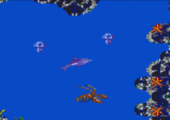
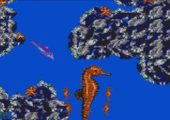
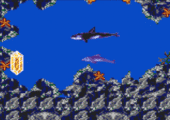
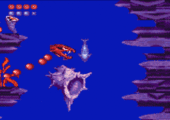
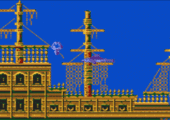
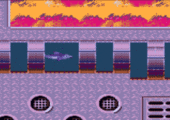
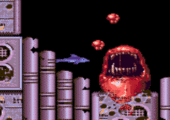
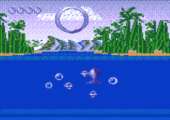

Recent Comments